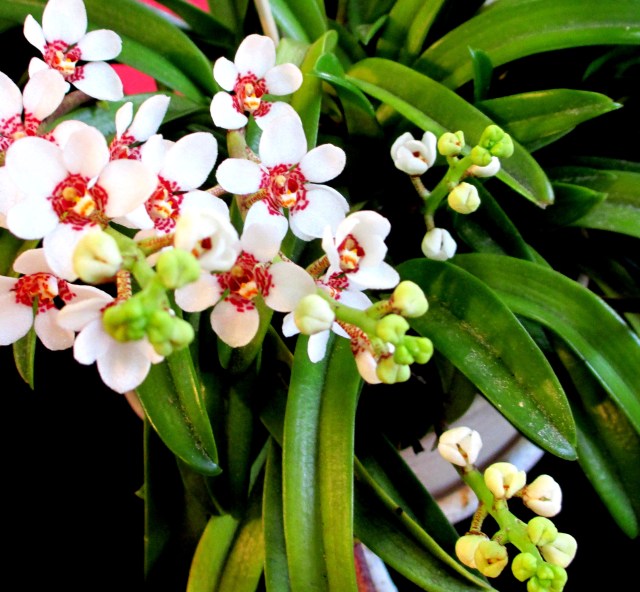Most Sarcochilus (pronounced Sar-co-kyle-us) orchids are native to Australia; with only one species being found overseas. The most widely grown species (Sarcochilus hartmannii, S. fitzgeraldii and S. ceciliae) grow on rocks in the areas of New South Wales or Queensland. However all three of these species grow happily in pots in Melbourne shade houses.
- Another species (S. falcatus) is found growing mostly on tree trunks, and is best grown on mounts, such as pieces of tree branch.
- Many hybrids have been made in recent years using the above four species, and also some of the other sarcochilus species that are less amenable to cultivation.
- In many instances these hybrids show hybrid vigour and are even easier to grow than their parent species.
The following information is from an article entitled: “Growing Sarcochilus Orchids in the Melbourne Area” by Ted Elgood, published in More Orchids in Victoria (2002)
Introduction: Sarcochilus species and hybrids provide an exquisite floral display, from the miniature flowers of Sarcochilus hillii to the very much larger flowers of hybrids such as S. Melba and S. Judith. The colour range, greatly extended in the last five years, now includes white, pastel pink to full red, yellow and orange, as well as flowers with beautifully patterned spots, splashes and bands. Shapes vary from the round, filled-in flowers of S. hartmannii to the round, open shape of S. fitzgeraldii flowers, the elongated flowers of S. olivaceous and S. spathulatus, and the starry or spider-shaped flowers of Rhinerrhiza divitiflora and its hybrids with Sarcochilus, adding to the beauty of this alliance. The primary purpose of this paper is to discuss the cultural conditions necessary to grow these orchids to their full glory. More information from this article by Elgood can be found here.
Further information relating to this exciting genus is found in the following “Cultural Notes: How to grow sarcochilus.” This article describes typical climatic conditions in the Melbourne area and particularly the Yarra Valley to the north of the city and summarised as follows :
- January, February and March – Hot days and warm nights; the days are long and bright, and the humidity generally low, particularly on days with strong north-easterly winds.
- April and May – Temperatures moderating, days becoming shorter, light intensity decreasing, humidity increasing.
- June and July – Cold days and nights, occasional frosts, some mornings below freezing, humidity generally high, short days, dull light.
- August and September – Days are warm, but nights are cool to cold, days longer, humidity generally high.
- October, November and December – increasing day and night temperatures, increasing day length and light intensity; usually the wettest season.
Further information from these Cultural Notes are located here.
For further information on Sarchochilus and other orchid varieties, see the Orchid Societies Council of Victoria (OSCOV) Website under the section Articles & Resources.
For photos of Sarcochilus see our Sarcochilus photo page.
- For further information about orchid care at Southern Suburbs Orchid Society (SSOS) or membership inquiries, please do not hesitate to Contact Us.
Southern Suburbs Orchid Society: Website | About Us | Contact Us | Facebook |Twitter
“Where Friends Meet”

















